Plot summary
Gideon Planish (1943) takes aim at less-than-honorable fundraising organizations. In a similar manner of his other works, the reader follows the self-titled character through his life and numerous (but slightly related) professions dealing with professional "organizationality" which is better known as the for-profit industry of pompous fundraising run by shady "philanthropists" running a wide variety of guilds, committees, foundations, leagues and councils for selfish and greedy purposes.
The focus of the book begins with a young Gideon demonstrating a knack for public speaking, and these skills follow him through his self-motivated and selfish undergraduate years at Adelbert College. The book then picks up an older but still vacuous Gideon, now a Professor of Rhetoric at Kinnikinick College, when he finally meets the girl of his dreams; young coed Peony Jackson of Faribault, Minnesota.
Motivated by vague dreams of importance, including a dream of becoming a U.S. senator, Gideon begins his campaign for social ascension by moving from one job to another with the hopes of meeting "like-minded thinkers" with vague goals and even more flexible morals when it came to raising money for a wide variety of causes. Over the years, Gideon's path to easy money with no accountability leads him to:
- The Dean of Kinnikinick College where he begins to use this role as a springboard of notoriety by banishing books (Garfield County Censorship Board) and join do-nothing boards (including the Sympathizers with the Pacifistic Purposes of the New Democratic Turkey) to get his name out in the marketplace of opportunity.
- Editor of Rural Adult Education publication
- Itinerant Lecturer (between jobs) reusing his inventory of high style/low content messages.
- Managing Secretary of the Heskett Rural School Foundation
- Administration of the Association to Promote Eskimo Culture
- Ghostwriter of the autobiography of William T. Knife, creator of Okey-Dokey, a beverage juiced with maximum caffeine for the masses
- Assistant General Manager of the Citizen's Conference on Constituational Crisises in the Commonwealth (Cizcon)
- Director General of "Every Man a Priest Fraternity" office
- Directive Secretary of the Dynamos of Democratic Direction
At 50 years old, when fatigued with the never-ending demands of generating self-importance combined with his realization that he lacked substance and true gravitas, Gideon has an opportunity to return to Kinnikinick College as its next President and allow him to finally begin to achieve something valid. Through a series of realizations by both himself and Peony, he remains in New York and daily regrets their decision.
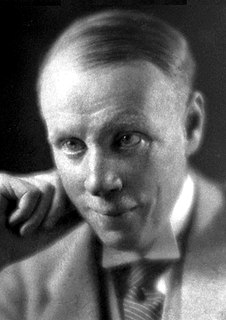
Harry Sinclair Lewis was an American writer and playwright. In 1930, he became the first writer from the United States to receive the Nobel Prize in Literature, which was awarded "for his vigorous and graphic art of description and his ability to create, with wit and humor, new types of characters." His works are known for their critical views of American capitalism and materialism between the wars. He is also respected for his strong characterizations of modern working women. H. L. Mencken wrote of him, "[If] there was ever a novelist among us with an authentic call to the trade ... it is this red-haired tornado from the Minnesota wilds."
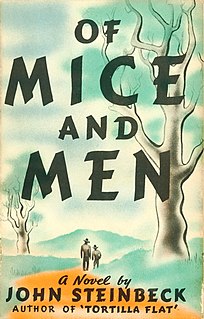
Of Mice and Men is a novella written by John Steinbeck. Published in 1937, it narrates the experiences of George Milton and Lennie Small, two displaced migrant ranch workers, who move from place to place in California in search of new job opportunities during the Great Depression in the United States.
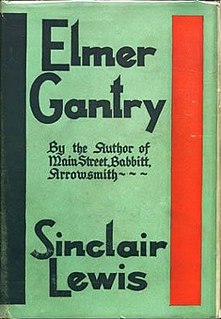
Elmer Gantry is a satirical novel written by Sinclair Lewis in 1926 that presents aspects of the religious activity of America in fundamentalist and evangelistic circles and the attitudes of the 1920s public toward it. The novel's protagonist, the Reverend Dr. Elmer Gantry, is initially attracted by booze and easy money and chasing women. After various forays into evangelism, he becomes a successful Methodist minister despite his hypocrisy and serial sexual indiscretions.
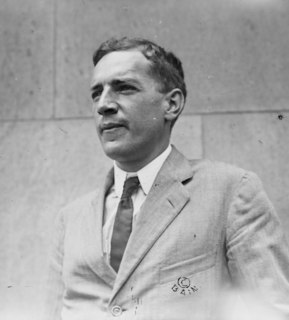
Upton Beall Sinclair Jr. was an American writer who wrote nearly 100 books and other works in several genres. Sinclair's work was well known and popular in the first half of the 20th century, and he won the Pulitzer Prize for Fiction in 1943.

The Jungle is a 1906 novel by the American journalist and novelist Upton Sinclair (1878–1968). The novel portrays the harsh conditions and exploited lives of immigrants in the United States in Chicago and similar industrialized cities. Sinclair's primary purpose in describing the meat industry and its working conditions was to advance socialism in the United States. However, most readers were more concerned with several passages exposing health violations and unsanitary practices in the American meat packing industry during the early 20th century, which greatly contributed to a public outcry which led to reforms including the Meat Inspection Act. Sinclair said of the public reaction, "I aimed at the public's heart, and by accident I hit it in the stomach."

That Hideous Strength is a 1945 novel by C. S. Lewis, the final book in Lewis's theological science fiction Space Trilogy. The events of this novel follow those of Out of the Silent Planet and Perelandra and once again feature the philologist Elwin Ransom. Yet unlike the principal events of those two novels, the story takes place on Earth rather than in space or on other planets in the solar system. The story involves an ostensibly scientific institute, the N.I.C.E., which is a front for sinister supernatural forces.

Lü Dongbin was a Chinese scholar and poet during the Tang Dynasty who has been elevated to the status of an immortal in the Chinese cultural sphere, worshipped especially by the Taoists. Lü is one of the most widely known of the group of deities known as the Eight Immortals and considered by some to be the de facto leader. He is also a historical figure who was mentioned in the official history book History of Song. Lü is widely considered to be one of the earliest masters of the tradition of neidan, or internal alchemy. He is depicted in art as being dressed as a scholar and he often bears a sword on his back that dispels evil spirits.
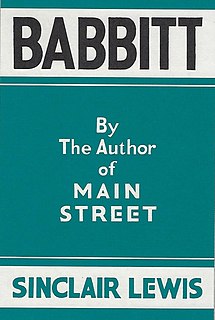
Babbitt (1922), by Sinclair Lewis, is a satirical novel about American culture and society that critiques the vacuity of middle class life and the social pressure toward conformity. The controversy provoked by Babbitt was influential in the decision to award the Nobel Prize in Literature to Lewis in 1930.

Main Street is a satirical novel written by Sinclair Lewis, and published in 1920.
Winnemac is a fictional U.S. state invented by the writer Sinclair Lewis. His novel Babbitt takes place in Zenith, its largest city. Winnemac is also a setting for Gideon Planish, Arrowsmith, Elmer Gantry, and Dodsworth.

Demian: The Story of Emil Sinclair's Youth is a Bildungsroman by Hermann Hesse, first published in 1919; a prologue was added in 1960. Demian was first published under the pseudonym "Emil Sinclair", the name of the narrator of the story, but Hesse was later revealed to be the author.
John Creasey was an English crime writer, also writing romance and western novels, who wrote more than six hundred novels using twenty-eight different pseudonyms.
The Make-A-Wish Foundation is a 501(c)(3) nonprofit organization founded in the United States that helps fulfill the wishes of children with a critical illness between the ages of 2 1/2 and 18 years old. Make-A-Wish was founded and is headquartered in Phoenix. The organization operates through its 59 chapters located throughout the United States. Make-A-Wish also operates in nearly 50 other countries around the world through 39 international affiliates.

Richter 10 is a 1996 science fiction novel by Arthur C. Clarke and Mike McQuay. The protagonist is Lewis Crane, who develops a hatred of earthquakes due to a major earthquake hitting his house when he is seven years old, killing his parents. The book's title is a reference to the Richter scale, on which 10 was considered to be the most power an earthquake was likely to ever have.

Dream of Fair to Middling Women is Samuel Beckett’s first novel. Written in English "in a matter of weeks" in 1932 when Beckett was only 26 and living in Paris, the clearly autobiographical novel was rejected by publishers and shelved by the author. The novel was eventually published in 1992, three years after the author's death.
Chris Petit is an English novelist and filmmaker. During the 1970s he was Film Editor for Time Out and wrote in Melody Maker. His first film was cult British road movie Radio On, while his 1982 film An Unsuitable Job for a Woman was entered into the 32nd Berlin International Film Festival. His films often have a strong element of psychogeography, and he has worked frequently with the writer Iain Sinclair. He has also written a number of crime novels, including Robinson (1993).
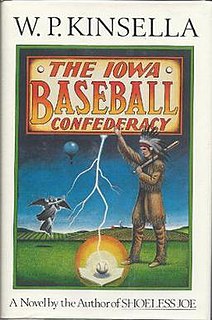
The Iowa Baseball Confederacy is a 1986 novel written by Canadian author W.P. Kinsella. It is less well known than his novel Shoeless Joe, which came to prominence when it was made into the film Field of Dreams. Like in Shoeless Joe, baseball is at the heart of the novel, which uses magic realism to blend events and individuals past and present with the author's love of the game. However, it covers more themes than Shoeless Joe and it explores a greater number of plot lines.
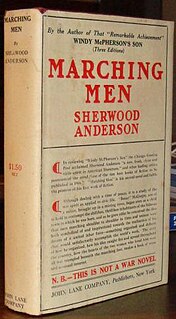
Marching Men is a 1917 novel by American author Sherwood Anderson. Published by John Lane, the novel is Anderson's second book; the first being the 1916 novel Windy McPherson's Son. Marching Men is the story of Norman "Beaut" McGregor, a young man discontented with the powerlessness and lack of personal ambition among the miners of his hometown. After moving to Chicago he discovers his purpose is to empower workers by having them march in unison. Major themes of the novel include the organization of laborers, eradication of disorder, and the role of the exceptional man in society. The latter theme led post-World War II critics to compare Anderson's militaristic approach to homosocial order and the fascists of the War's Axis powers.
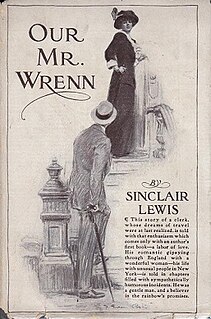
Our Mr. Wrenn: The Romantic Adventures of a Gentle Man is a 1914 novel by Sinclair Lewis and the first to be published under his real name.
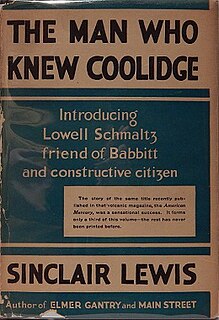
The Man Who Knew Coolidge is a 1928 satirical novel by Sinclair Lewis. It features the return of several characters from Lewis' previous works, including George Babbitt and Elmer Gantry. Additionally, it sees a return to the familiar territory of Lewis' fictional American city of Zenith, in the state of Winnemac. Presented as six long, uninterrupted monologues by Lowell Schmalz, a travelling salesman in office supplies, the eponymous first section was originally published in The American Mercury in 1927.
















